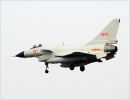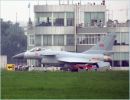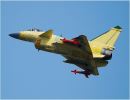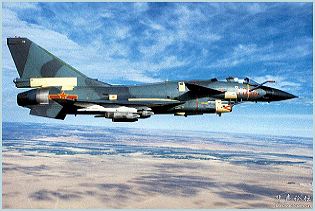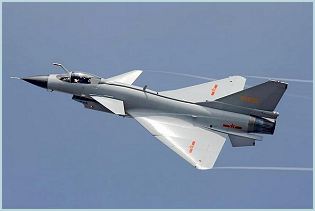Chengdu J-10
| a | ||||||||||||||||||||||
|
J-10 Chengdu fighter aircraft
|
||||||||||||||||||||||
|
|
||||||||||||||||||||||
|
|
||||||||||||||||||||||
|
The J-10 Chengdu is a multi-role fighter aircraft, produced by the Chengdu Aircraft Industry Co. (CAC). The program began in 1986 with the goal of developing a fighter that could counter the Russian MiG-29 and Su-27 fighters. The J-10 is a capable fighter-bomber, which will be operated alongside China's interceptor fleet of J-11 licensed built Su-27 and the imported Su-30MK Flankers. It will boast China's tactical air-to-ground capability replacing the older J-7 and Q-5 attack aircraft. The J-10 was officially unveiled by the Chinese government in January 2007, when photographs were published by Xinhua News Agency. The aircraft's existence was known long before the announcement, although concrete details remained scarce due to secrecy. In the official announcement Xinhua News Agency and the PLA Daily denied rumours that one of the prototypes had crashed during testing, and listed this is one of the test pilots' accomplishments. Later reports confirmed the crash and the subsequent cover-up. The first plane, "J-10 01", rolled out in November 1997. Its successful maiden was flown on 23 March 1998 by test pilot Lei Qiang and lasted twenty minutes. The J-10 were first delivered to the 13th Test Regiment on 23 February 2003. The aircraft was declared 'operational' in December of the same year, after 18 years in development. The first operational regiment was the 131st Regiment of the 44th Division. The J-10 is also used by the Pakistani air Force. The J-10s would be modified to Pakistani requirements, and be delivered to two PAF squadrons in 2014–2015 as the FC-20 |
||||||||||||||||||||||
| Variants | ||||||||||||||||||||||
|
|
||||||||||||||||||||||
|
||||||||||||||||||||||
|
|
||||||||||||||||||||||
|
||||||||||||||||||||||
|
|
||||||||||||||||||||||
|
||||||||||||||||||||||
|
|
||||||||||||||||||||||
|
||||||||||||||||||||||
|
|
||||||||||||||||||||||
|
||||||||||||||||||||||
| Technical Data | ||||||||||||||||||||||
| Design | ||||||||||||||||||||||
|
J-10 was designed by the Chengdu Aircraft Design Institute (CADI), a subordinate research institute of Chengdu Aircraft Industry Corporation (CAIC). The J-10 adopts a “tailless delta-canard” aerodynamic layout, which was originally developed for the cancelled J-9 fighter. The aircraft has the horizontal control surfaces moved forward to become a canard in front of the wing. When the aircraft pitches up, instead of forcing the tail down decreasing overall lift, the canard lifts the nose, increasing the overall lift. Because the canard is picking up the fresh air stream instead of the wake behind the main wing, the aircraft can achieve better control authority with a smaller-size control surface, thus resulting in less drag and less weight.
|
||||||||||||||||||||||
| Avionic | ||||||||||||||||||||||
|
Due to the J-10's aerodynamically unstable design, a digital quadruplex-redundant fly-by-wire flight control system aids the pilot in flying the aircraft. Chinese aircraft designer Yang Wei is claimed to be the chief designer of the fly-by-wire flight control system, although this is disputed by analyst Richard Fisher who credits Israeli consultants for developing the system. The flight control computer provides automatic flight coordination and keeps the aircraft from entering potentially dangerous situations such as unintentional slops or skids. This therefore frees the pilot to concentrate on his intended tasks during combat. |
||||||||||||||||||||||
| Propulsion | ||||||||||||||||||||||
|
The J-10 is powered by a single Russian Lyulka-Saturn AL-31FN turbofan engine giving a maximum static power output of 11,700 kgf. The most significant difference between the AL-31FN and the AL-31F is the arrangement of certain parts and mechanisms due to spacial limitations of the engine bay in the J-10. The AL-31F is designed for a twin engine aircraft such as the Su-27. For the J-10's AL-31FN variant, protruding parts of the engine such as the gearbox and pump are mounted opposite to that of AL-31F.
The AL-31FN was initially expected to be replaced by a domestic powerplant developed and manufactured in China, the WS-10A (WoShan-10A) Taihang turbofan, giving a thrust of 129 kN (13,200 kgf or 29,101 lbf); however, the PLAAF delayed integration of the WS-10 onto the aircraft given development difficulties with the engine. Russia has offered to provide China with a version of the AL-31FN that provides 12,500 kgf thrust and a 2,000-hour service life. |
||||||||||||||||||||||
| Armament | ||||||||||||||||||||||
|
The fixed armament of the J-10 includes an internally-mounted Type 23-3 twin-barrel 23mm cannon, located on the port side of the front landing gear. The gas-operated cannon has a combat weight of 50.5kg, a length of 1,530mm, and a maximum rate of fire of 3,000~3,4000 rounds/minute. The cannon fires 320g, 23X200mm high-explosive/incendiary with tracer round and armour-piercing round, with a muzzle velocity of 715m/s. The cannon is electric-driven using 27V 8A DC. The J-10 has 11 external stores stations for weapon carriage, three under each wing and five under the fuselage. For air-superiority and interception missions, the J-10 could carry a mix of medium-range air-to-air missiles (MRAAM), short-range air-to-air missiles (SRAAM). The J-10 can also carry laser-guided bombs (LT-2), glide bombs (LS-6) and unguided bombs.
|
||||||||||||||||||||||
| Specifications | ||||||||||||||||||||||
|
||||||||||||||||||||||
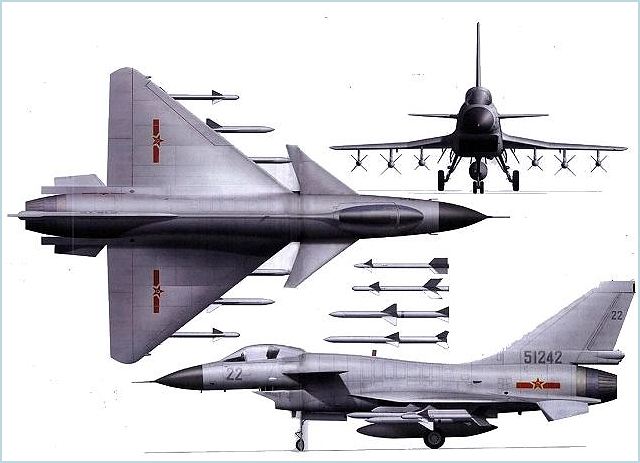 |
||||||||||||||||||||||
|
||||||||||||||||||||||






























